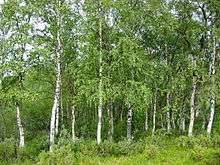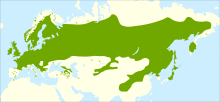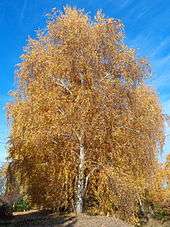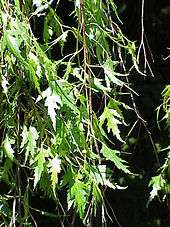Betula pendula
| Silver birch Betula pendula | |
|---|---|
 | |
| Silver birch forest, Inari, Finland | |
| Scientific classification | |
| Kingdom: | Plantae |
| (unranked): | Angiosperms |
| (unranked): | Eudicots |
| (unranked): | Rosids |
| Order: | Fagales |
| Family: | Betulaceae |
| Genus: | Betula |
| Subgenus: | Betula |
| Species: | B. pendula |
| Binomial name | |
| Betula pendula Roth | |
 | |
| Distribution map | |
| Synonyms | |
|
See text | |
Betula pendula, commonly known as silver birch or warty birch, is a species of tree in the family Betulaceae, native to Europe and parts of Asia, though in southern Europe it is only found at higher altitudes. Its range extends into Siberia, China and southwest Asia in the mountains of northern Turkey, the Caucasus and northern Iran. It has been introduced into North America, where it is known as the European white birch, and is considered invasive in some states in USA and in parts of Canada. The tree can also be found in more temperate regions of Australia.
The silver birch is a medium-sized deciduous tree that owes its common name to the white peeling bark on the trunk. The twigs are slender and often pendulous and the leaves are roughly triangular with doubly serrate margins and turn yellow in autumn before they fall. The flowers are catkins and the light, winged seed get widely scattered by the wind. The silver birch is a hardy tree, a pioneer species, and one of the first trees to appear on bare or fire-swept land. Many species of birds and animals are found in birch woodland, the tree supports a wide range of insects and the light shade it casts allows shrubby and other plants to grow beneath its canopy. It is planted decoratively in parks and gardens and is used for forest products such as joinery timber, firewood, tanning, racecourse jumps and brooms. Various parts of the tree are used in traditional medicine and the bark contains triterpenes which have been shown to have medicinal properties.
Description

The silver birch is a medium-sized deciduous tree, typically reaching 15 to 25 m (49 to 82 ft) tall (exceptionally up to 31 metres (102 ft)),[1] with a slender trunk usually under 40 cm (16 in) diameter. The bark on the trunk and branches is golden-brown at first, but later this turns to white as a result of papery tissue developing on the surface and peeling off in flakes, in a similar manner to the closely-related Paper birch (B. papyrifera). The bark remains smooth until the tree gets quite large, but in older trees, the bark thickens, becoming irregular, dark and rugged. Young branches have whitish resin warts and the twigs are slender, hairless and often pendulous. The buds are small and sticky, and development is sympodial, that is to say the terminal bud dies away and growth continues from a lateral bud. Some shoots are long and bear the male catkins at the tip, while others are short and bear female catkins. The immature male catkins are present during the winter but the female catkins develop in the spring, soon after the leaves unfurl.[1]
The leaves have short slender stalks and are 3 to 7 cm (1.2 to 2.8 in) long, triangular with broad, untoothed, wedge-shaped bases, slender pointed tips and coarsely double-toothed, serrated margins. They are sticky with resin at first but this dries as they age leaving small white scales. The foliage is a pale to medium green and turns yellow early in the autumn before the leaves fall. In mid-summer, the female catkins mature and the male catkins expand and release pollen, and wind pollination takes place. The small 1 to 2 mm winged seeds ripen in late summer on pendulous, cylindrical catkins 2 to 4 cm (0.8 to 1.6 in) long and 7 mm (0.3 in) broad. The seeds are very numerous and are separated by scales, and when ripe, the whole catkin disintegrates and the seeds are spread widely by the wind.[1][2]
Distribution and habitat
The silver birch grows naturally from western Europe eastwards to Kazakhstan, the Sakha Republic in Siberia, Mongolia and the Xinjiang province in China, and southwards to the mountains of the Caucasus and northern Iran, Iraq and Turkey. It is also native to northern Morocco and has become naturalised in some other parts of the world.[3] In the southern parts of its range it is mainly found in mountainous regions. Its light seeds are easily blown by the wind and it is a pioneer species, one of the first trees to sprout on bare land or after a forest fire. It needs plenty of light and does best on dry, acid soils and is found on heathland, mountainsides and clinging to crags.[1] Its tolerance to pollution make it suitable for planting in industrial areas and exposed sites.[4] It has been introduced into North America where it is known as the European white birch, and is considered invasive in the states of Kentucky, Maryland, Washington and Wisconsin.[5] It is naturalised and locally invasive in parts of Canada.[6]
Taxonomy


The closely related Betula platyphylla in northern Asia and Betula szechuanica of central Asia are also treated as varieties of silver birch by some botanists, as B. pendula var. platyphylla and B. pendula var. szechuanica respectively (see birch classification).[7]
B. pendula is distinguished from the related downy birch (B. pubescens, the other common European birch) in having hairless, warty shoots (hairy and without warts in downy birch), more triangular leaves with double serration on the margins (more ovoid and with single serrations in downy birch), and whiter bark often with scattered black fissures (greyer, less fissured, in downy birch). It is also distinguished cytologically, silver birch being diploid (with two sets of chromosomes), whereas downy birch is tetraploid (four sets of chromosomes). Hybrids between the two are known, but are very rare, and being triploid, are sterile.[8] The two have differences in habitat requirements, with silver birch found mainly on dry, sandy soils, and downy birch more common on wet, poorly drained sites such as clay soils and peat bogs. Silver birch also demands slightly more summer warmth than does downy birch, which is significant in the cooler parts of Europe. Many North American texts treat the two species as conspecific (and cause confusion by combining the downy birch's alternative vernacular name 'white birch', with the scientific name B. pendula of the other species), but they are regarded as distinct species throughout Europe.[2]
Synonyms include Betula pendula var. carelica (Merckl.) Hämet-Ahti, B. pendula var. laciniata (Wahlenb.) Tidestr., B. pendula var. lapponica (Lindq.) Hämet-Ahti, B. aetnensis Raf., B. montana V.N.Vassil, B. talassica Poljakov, B. verrucosa Ehrh., B. verrucosa var. lapponica Lindq., and B. fontqueri Rothm.[9][10] The rejected name Betula alba L. also applied in part to B. pendula, though also to B. pubescens.[11]
Ecology
The silver birch has an open canopy which allows plenty of light to reach the ground. This allows a variety of mosses, grasses and flowering plants to grow beneath which in turn attract insects. Flowering plants often found in birch woods include primrose (Primula vulgaris), violet (Viola riviniana), bluebell (Hyacinthoides non-scripta), wood anemone (Anemone nemorosa) and wood sorrel (Oxalis acetosella). Small shrubs that grow on the forest floor include blaeberry (Vaccinium myrtillus) and cowberry (Vaccinium vitis-idaea).[2] Birds found in birch woodland include the chaffinch, tree pipit, willow warbler, nightingale, robin, woodcock, redpoll and green woodpecker.[4]
The branches of the silver birch often have tangled masses of twigs known as witch's brooms growing among them, caused by the fungus Taphrina betulina. Old trees are often killed by the decay fungus Piptoporus betulinus and fallen branches rot rapidly on the forest floor. This tree commonly grows with the mycorrhizal fungus Amanita muscaria in a mutualistic relationship. This applies particularly to acidic or nutrient-poor soils. Other mycorrhizal associates include Leccinum scabrum and Cantharellus cibarius.[2] It has been shown that, as well as mycorrhiza, the presence of microfauna in the soil assists the growth of the tree, as it enhances the mobilization of nutrients.[12]
The larvae of a large number of species of butterflies, moths and other insects feed on the leaves and other parts of the silver birch.[13] In Germany, almost 500 species of insect have been found on silver and downy birch including 106 beetles and 105 lepidopterans, with 133 insect species feeding almost exclusively on birch.[14] Birch dieback disease can affect planted trees, while naturally regenerated trees seem less susceptible.[15] This disease also affects Betula pubescens and in 2000 was reported at many of the sites planted with birch in Scotland during the 1990s.[16] In the United States, the wood is attacked by the bronze birch borer (Agrilus anxius), an insect pest to which it has no natural resistance.[5]
Uses
Silver birch is often planted in parks and gardens, grown for its white bark and gracefully drooping shoots, sometimes even in warmer-than-optimum places such as Los Angeles and Sydney. In Scandinavia and other regions of northern Europe, it is grown for forest products such as lumber and pulp, as well as for aesthetic purposes and ecosystem services. It is sometimes used as a pioneer and nurse tree elsewhere.[1]
Silver birch wood is pale in colour with no distinct heartwood and is used in making furniture, plywood, veneers, parquet blocks, skis, kitchen utensils and in turnery. It makes a good firewood that produces a good heat when burnt but is quickly consumed by the flames. Slabs of bark are used for making roof shingles and wooden footwear.[1] Historically, the bark was used for tanning. Bark can be heated and the resin collected; the resin is an excellent waterproof glue and useful for starting fires. The thin sheets of bark that peel off young wood contain a waxy resin and are easy to ignite even when wet. The dead twigs are also useful as kindling for outdoor fires.[17]
Birch brushwood is used for racecourse jumps and besom brooms. In the spring, large quantities of sap rise up the trunk and this can be tapped. It contains around 1% sugars and can be used in a similar way to maple syrup, being drunk fresh, concentrated by evaporation or fermented into a "wine".[17] In Sweden, the bark of birch trees was ground up and used to make bark bread, a form of famine food. The removal of bark was at one time so widespread that Carl Linnaeus expressed his concern for the survival of the woodlands.[18]
Silver birch is used in traditional medicine as a diuretic and is reputed to be useful in the treatment of high blood pressure, high cholesterol, obesity, gout, kidney stones, nephritis, cystitis, digestive disturbances and respiratory diseases. For these purposes, a decoction of the bark or leaves is generally used. Externally silver birch is used to promote healing, relieve pain and treat inflammations and infections of the skin such as eczema and psoriasis.[19]
The outer part of the bark contains up to 20% betulin. The main components in the essential oil of the buds are α-copaene (~10%), germacrene D (~15%) and δ-cadinene (~13%).[20] Also present in the bark are other triterpene substances which have been shown to have anti-inflammatory, antiviral and anti-cancer properties.[21]
The silver birch is Finland's national tree.[22] Leafy, fragrant boughs of silver birch (called vihta or vasta) are used to gently beat oneself in the Finnish sauna culture.[23]
Cultivation

Successful birch cultivation requires a climate cool enough for at least the occasional winter snowfall. As they are shallow-rooted, they may require water during dry periods. They grow best in full sun planted in deep, well-drained soil.[24]
Cultivars
- 'Carelica' is called "curly birch" in Finland; the wood is hard and decorative and is used in wood-carving.[25]
- 'Laciniata' agm (commonly misidentified as 'Dalecarlica') has deeply incised leaves and weeping branches.[26]
- 'Purpurea' has dark purple leaves.[27]
- 'Tristis' agm has an erect trunk with weeping branchlets.[28]
- 'Youngii' has dense, twiggy weeping growth with no central leader and requires being grafted onto a standard stem of normal silver birch.[29]
The cultivars marked agm above have gained the Royal Horticultural Society's Award of Garden Merit.
See also
References
- 1 2 3 4 5 6 Vedel, Helge; Lange, Johan (1960). Trees and Bushes. Methuen. pp. 141–143. ISBN 978-0-416-61780-1.
- 1 2 3 4 Featherstone, Alan Watson. "Silver birch, downy birch". Trees for Life. Retrieved 2014-05-28.
- ↑ "GRIN Taxonomy for Plants - Betula pendula". USDA Agricultural Research Service. Retrieved 2014-05-29.
- 1 2 "Silver birch: Betula pendula". Forestry Commission. Retrieved 2014-05-28.
- 1 2 "European White Birch - Betula pendula" (PDF). USDA Forest Service. 2006-09-01. Retrieved 2014-05-29.
- ↑ Diamond, Joshua; Browning, Mark; Williams, Andrew; Middleton, John (2003). "Lack of Evidence for Impact of the European White Birch, Betula pendula, on the Hydrology of Wainfleet Bog, Ontario". Canadian Field-Naturalist. 117 (3).
- ↑ Hunt, D., ed. (1993). Betula. Proceedings of the IDS Betula Symposium 2–4 October 1992. p. 51. International Dendrology Society ISBN 0-9504544-5-1.
- ↑ OECD (2008). Novel Food and Feed Safety SET 1: Safety Assessment of Transgenic Organisms OECD Consensus Documents Volumes 1 and 2. OECD Publishing. p. 58. ISBN 978-92-64-05346-5.
- ↑ Anderberg, Arne (1999-10-14). "Betula pendula Roth". Den virtuella floran. Naturhistoriska riksmuseet. Retrieved 2014-05-29.
- ↑ Govaerts, R.; Frodin, D. G. (1998). World Checklist and Bibliography of Fagales. ISBN 1-900347-46-6 online search
- ↑ Govaerts, R. (1996). "Proposal to reject the name Betula alba (Betulaceae)". Taxon. 45: 697–698. doi:10.2307/1224262.
- ↑ Setälä, Heikki; Huhta, Veikko (1991). "Soil Fauna Increase Betula pendula Growth: Laboratory Experiments With Coniferous Forest Floor". Ecology. 72 (2): 665–671. doi:10.2307/2937206. JSTOR 2937206.
- ↑ "HOSTS - a Database of the World's Lepidopteran Hostplants". Natural History Museum. Retrieved 2014-05-29.
- ↑ Brändle, Martin; Brandl, Roland (2001). "Species richness of insects and mites on trees: expanding Southwood". Journal of Animal Ecology. 70 (3): 491–504. doi:10.1046/j.1365-2656.2001.00506.x.
- ↑ "Birch, downy (Betula pubescens)". Woodland Trust. Retrieved 10 May 2016.
- ↑ "Dieback of birch". Forestry Commission. Retrieved 10 May 2016.
- 1 2 Cox, Michael O. "Firewood types: silver birch". WoodstoveWizard.com. Retrieved 2014-05-29.
- ↑ Julie Lindahl (2011-01-09). "Bark Bread is back". Nordic Wellbeing. Retrieved 2011-07-21.
- ↑ "Betula pendula - Roth.". Plants for a future. Retrieved 2014-11-05.
- ↑ Demirci, Betül; Paper, Dietrich H.; Demirci, Fatih; Başer, K. Hüsnü Can; Franz, Gerhard (2004). "Essential Oil of Betula pendula Roth. Buds". Evidence-Based Complementary and Alternative Medicine. 1 (3): 301–303. doi:10.1093/ecam/neh041. PMID 15841263.
- ↑ Kovac-Besović, E. E.; Durić, K.; Kalodera, Z.; Sofić, E (2009). "Identification and isolation of pharmacologically active triterpenes in Betuale cortex, Betula pendula Roth., Betulaceae". Bosnian Journal of Basic Medical Sciences. 9 (1): 31–38. PMID 19284392.
- ↑ Katriina Anttila (2005). "Suomen kansallistunnukset (Finland's national emblems)". Retrieved 2014-05-30.
- ↑ "Perinteinen saunavihta (Traditional sauna vihta)". Visit sauna. Retrieved 2014-05-30.
- ↑ Botanica (1999). Botanica's Trees & Shrubs. Laurel Glen Publishing A. p. 139. ISBN 978-1-57145-649-6.
- ↑ "Betula pendula var. carelica - curly birch". Arboretum Mustila. Retrieved 2014-11-12.
- ↑ "RHS Plant Selector - Betula pendula 'Laciniata'". Royal Horticultural Society. Retrieved 2013-06-14.
- ↑ "RHS Plant Selector - Betula pendula 'Purpurea'". Royal Horticultural Society. Retrieved 2014-11-12.
- ↑ "RHS Plant Selector - Betula pendula 'Tristis'". Royal Horticultural Society. Retrieved 2013-06-14.
- ↑ "RHS Plant Selector - Betula pendula 'Youngii'". Royal Horticultural Society. Retrieved 2014-11-12.
| Wikimedia Commons has media related to Betula pendula. |
| Wikispecies has information related to: Betula pendula |
External links
- EUFORGEN species page: Betula pendula Information, distribution and related resources